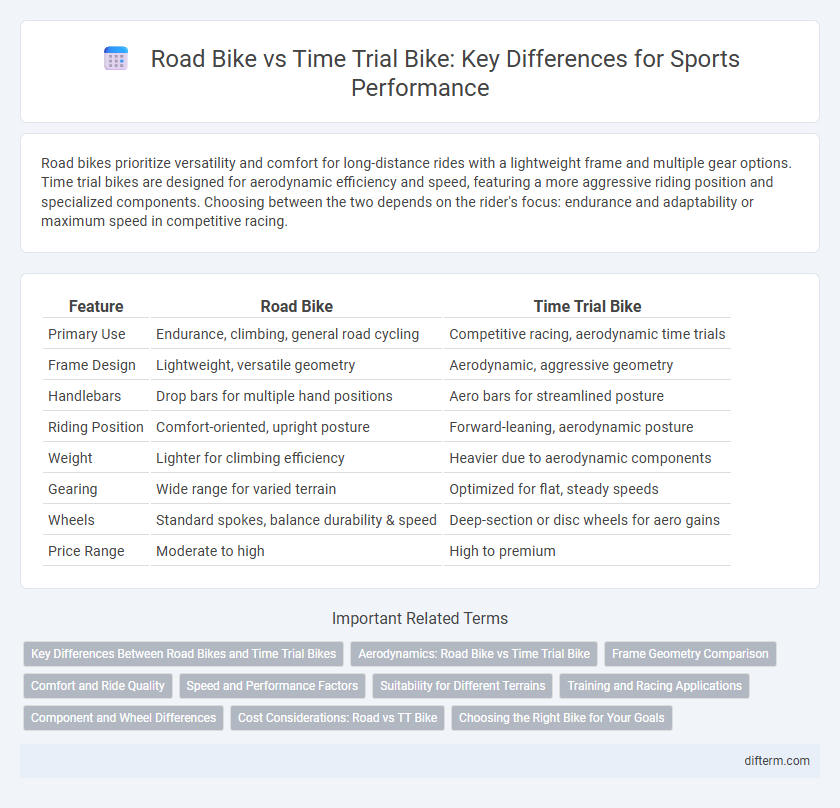Road bikes prioritize versatility and comfort for long-distance rides with a lightweight frame and multiple gear options. Time trial bikes are designed for aerodynamic efficiency and speed, featuring a more aggressive riding position and specialized components. Choosing between the two depends on the rider's focus: endurance and adaptability or maximum speed in competitive racing.
Table of Comparison
| Feature | Road Bike | Time Trial Bike |
|---|---|---|
| Primary Use | Endurance, climbing, general road cycling | Competitive racing, aerodynamic time trials |
| Frame Design | Lightweight, versatile geometry | Aerodynamic, aggressive geometry |
| Handlebars | Drop bars for multiple hand positions | Aero bars for streamlined posture |
| Riding Position | Comfort-oriented, upright posture | Forward-leaning, aerodynamic posture |
| Weight | Lighter for climbing efficiency | Heavier due to aerodynamic components |
| Gearing | Wide range for varied terrain | Optimized for flat, steady speeds |
| Wheels | Standard spokes, balance durability & speed | Deep-section or disc wheels for aero gains |
| Price Range | Moderate to high | High to premium |
Key Differences Between Road Bikes and Time Trial Bikes
Road bikes feature a more upright geometry designed for comfort and versatility on varied terrain, while time trial bikes prioritize aerodynamics with a forward-leaning position to minimize wind resistance. Time trial bikes typically have aero handlebars and integrated components that enhance speed during solo efforts, contrasting with road bikes' drop bars optimized for control and handling in group rides. Weight differences also matter: road bikes are generally lighter for climbing and agility, whereas time trial bikes emphasize stiffness and aerodynamic efficiency over overall weight.
Aerodynamics: Road Bike vs Time Trial Bike
Time trial bikes feature aerodynamic frames, integrated handlebars, and deep-section wheels designed to minimize air resistance at high speeds, significantly outperforming road bikes in reducing drag. Road bikes prioritize versatility and comfort with a more upright geometry and less aerodynamic components, resulting in higher wind resistance compared to time trial bikes. Aerodynamic efficiency in time trial bikes gives competitive cyclists crucial seconds in races against the clock.
Frame Geometry Comparison
Road bike frames feature a more relaxed geometry with a taller head tube and longer wheelbase, promoting comfort and stability during extended rides and varied terrain. Time trial bike frames have an aggressive, aerodynamic geometry with a lower front end and shorter wheelbase, optimizing rider positioning to minimize wind resistance and maximize speed in racing scenarios. The distinct frame angles and tube shapes in each bike type directly influence handling characteristics and rider efficiency based on their intended use.
Comfort and Ride Quality
Road bikes prioritize comfort with a more relaxed geometry, wider tires, and enhanced shock absorption, making them suitable for longer rides and varied terrains. Time trial bikes feature aggressive, aerodynamic designs that often sacrifice comfort for speed, resulting in a stiffer frame and a more forward-leaning position. Riders choosing between these should consider their primary goal: endurance and comfort favor road bikes, while competitive speed in flat, timed events suits time trial bikes.
Speed and Performance Factors
Time trial bikes maximize aerodynamic efficiency by incorporating aggressive frame geometry and aero handlebars, significantly reducing drag to enhance speed on flat, straight courses. Road bikes offer versatile performance with balanced aerodynamics and comfort, enabling better handling and endurance over varied terrain and longer distances. The stiffness-to-weight ratio in time trial bikes optimizes power transfer for sprinting, while road bikes prioritize shock absorption and stability to maintain consistent performance.
Suitability for Different Terrains
Road bikes excel on varied terrains with smooth surfaces, offering lightweight frames and responsive handling ideal for climbs and descents. Time trial bikes are engineered for flat, aerodynamic efficiency, maximizing speed on straight courses but compromising comfort and control on rough or hilly terrain. Cyclists should match bike choice to terrain type: road bikes for diverse routes and time trial bikes for flat, fast courses.
Training and Racing Applications
Time trial bikes offer aerodynamic advantages ideal for racing against the clock, while road bikes provide versatility for diverse training sessions and varied terrains. Training on a road bike enhances endurance and handling skills essential for group rides and long-distance events. Time trial bikes optimize performance in races prioritizing speed and aerodynamics but are less practical for everyday training due to their aggressive positioning and limited handling flexibility.
Component and Wheel Differences
Road bikes typically feature lightweight, aerodynamic components with a focus on versatility and comfort, using standard drop handlebars and a wider gear range for varied terrain. Time trial bikes prioritize aerodynamics with integrated components like aero handlebars, deeper section wheels, and specialized cranksets designed to reduce air resistance and enhance speed. Wheel differences are significant; road bikes use lighter, shallow-rim wheels for agility, while time trial bikes employ deep-section or disc wheels to minimize drag in flat, straight courses.
Cost Considerations: Road vs TT Bike
Road bikes generally offer a more affordable entry point, with models starting around $800, while time trial (TT) bikes often exceed $3,000 due to specialized aerodynamics and materials. Maintenance expenses for TT bikes can be higher owing to their complex components and custom fittings. Budget-conscious cyclists must weigh initial purchase price against long-term upkeep when choosing between road and time trial bikes.
Choosing the Right Bike for Your Goals
Choosing the right bike depends heavily on your cycling goals and riding style, with road bikes offering versatility and comfort for long-distance rides and group cycling, while time trial bikes prioritize aerodynamics and speed for competitive racing against the clock. Road bikes feature a more relaxed geometry, lightweight frames, and multiple gear options suited for varied terrains, making them ideal for endurance training and recreational cycling. Time trial bikes have aggressive riding positions, aerodynamic frame designs, and integrated components designed to minimize wind resistance, optimizing performance in individual time trials and triathlons.
road bike vs time trial bike Infographic

 difterm.com
difterm.com